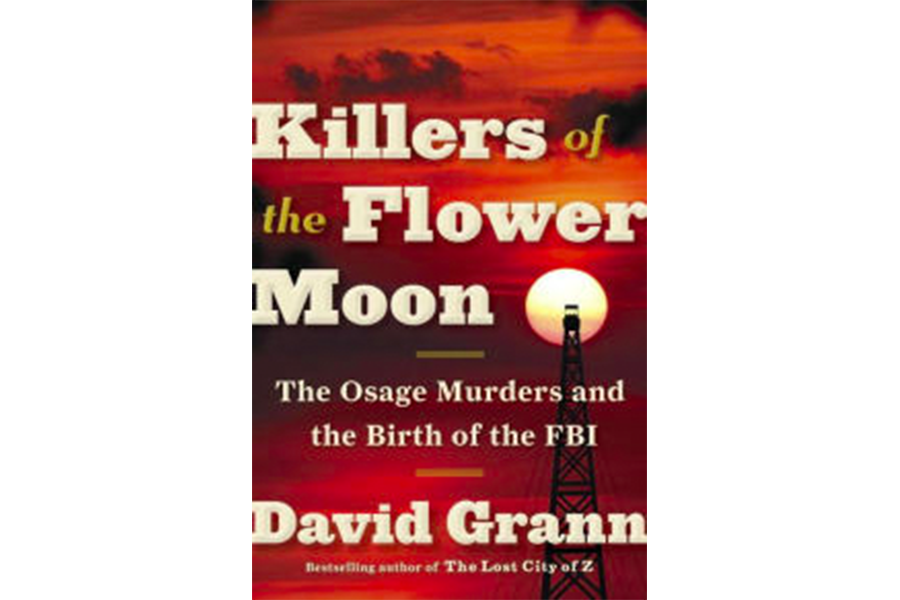'Killers of the Flower Moon' is a true crime slice of Native American history
Loading...
Now this is a story. New Yorker reporter David Grann delivers a haunting, inexplicably forgotten real-life tale of improbable wealth and unspeakable horror in his new book, which is all but certain to spend ample time on best-of and bestseller lists alike.
Killers of the Flower Moon delves into a string of mostly unsolved murders involving the Osage Indian Nation of Oklahoma in the 1920s. The title comes from an Osage saying that describes the death of blooming April flowers in May, when taller plants crowd them out.
The book arrives just as Grann’s 2009 debut, “The Lost City of Z,” has been adapted into a movie starring Charlie Hunnam, Robert Pattinson, and Sienna Miller. It tells the story of a Victorian British explorer who, in 1925, pursued a lost city in the Amazon to disastrous effect.
Like other Native American tribes, the Osage were forced from their native lands (Kansas, in this case) in the late-19th century, a process that wiped out two-thirds of their population in 70 years. Unlike other tribes, they settled on, and secured mining rights, to their new home – property in northeastern Oklahoma considered unforgiving and “presumably worthless.”
By 1923, oil leases and royalties generated $30 million in a single year for the Osage, or, as Grann notes, equal to $400 million today. Per-capita, the Osage people were the wealthiest in the United States at the time.
Reporters flocked to Oklahoma to write biased, unflattering, and often racist accounts of the tribe’s newfound oil wealth. One magazine journalist, after visiting the Osage, wrote, “Where will it end? Every time a new well is drilled the Indians are that much richer.… The Osage Indians are becoming so rich that something will have to be done about it.”
Something unimaginably sinister was already being done about it. Osage tribe members began and kept dying under mysterious circumstances during the 1920s, victims of powerful whites, some of whom had married into Osage families. Often poisoned, the Osage were targets because federal law imposed wardens and guardians as stewards of their money, whites who controlled the tribe members’ oil wealth and skimmed liberally while plotting murders that would give them access to all of the money.
The killings occurred at a time when detective work remained mostly shoddy. Grann spares few details, describing one murder scene in which a young Osage woman’s bloated corpse is discovered. To identify the body of Anna Brown, a family member “took a stick and pried open her mouth, and they could see Anna’s gold fillings,” Grann writes. The autopsy and inquest were carried out at the ravine where her body was discovered, a scene sketched by Grann with the blunt description, “Flies swarmed.”
Corruption ran rampant in local government, particularly with regard to Native Americans. Judges, undertakers, and doctors, as Grann’s meticulous research makes clear, conspired to cover up many more murders than the 24 thought to be solved by a former Texas Ranger named Tom White, sent to Oklahoma to solve the deaths after they stirred media interest.
White’s boss in the case? J. Edgar Hoover, an ambitious federal lawman in Washington who would use convictions tied to the Osage case to help establish the nascent FBI as a formidable force. Hoover maneuvered around initial errors and investigative missteps that would have been highly embarrassing had they become widely known.
White proved dogged and, after fits and starts, assembled a strong case. Grann handles the dramatic twists of the ensuing murder trial with aplomb and then delivers a first-person, contemporary coda that puts the stakes even higher.
As Grann’s account shows, the massacre of the Osage, including numerous children who died prematurely and were likely murder victims, haunts the tribe’s ancestors to this day. Predictably, the oil – which ran so freely in 1920 that a single well on Osage land pumped out 680 barrels in one day – ran dry and the Native Americans were left with nothing to show for their shrewd land deal.
“This land is saturated with blood,” a descendant of an Osage murder victim tells Grann. Readers will find the stain of that blood all but impossible to wash away after reading Grann’s absorbing but disturbing story.








